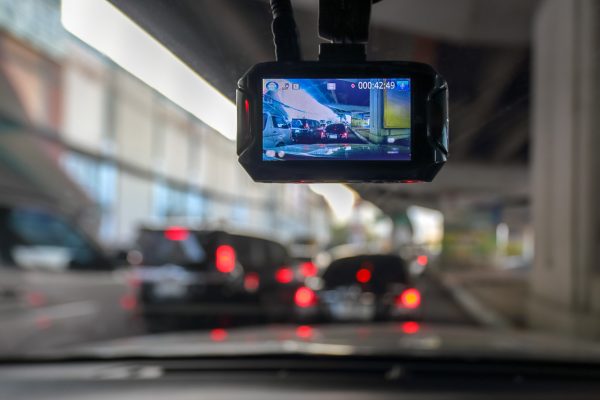Dashcams vs. Multi-Channel Cameras: What’s Best for Your Fleet?
March 2, 2022
Running a fleet can be a challenge, whether you’re new to the industry or a seasoned pro. One thing all fleet managers can agree on is the need for technology that makes their lives easier, while keeping drivers and their cargo safe.
One solution that has taken a quantum leap across the technology chasm is the multi-channel camera. This intelligent device has been used for various applications within the commercial fleet industry, most notably as a driver behaviour monitoring system. Multi-channel camera solutions help drivers become more efficient, productive, and safe.
This article will compare the two types of cameras available for use with commercial truck fleets: multi-channel cameras and dashcams.

Why Do You Need a Camera Solution for Your Fleet?
Whether you have one truck or an entire fleet, safety on the road is always top of mind. All attention has turned to the trucking industry of late, further highlighting how high the stakes can be if your drivers take safety for granted.
One mistake could lead to dire consequences, for your team and for your business. A dashcam solution can give you peace of mind by providing full visibility of the road, the cab, and your inventory. Read on for more benefits.

Insurance Benefits
One of the most significant benefits that come with using a camera system (be it a single dashcam or multi-channel camera solution) in your fleet is a potential reduction in insurance premiums. Insurance companies see vehicle camera systems as risk mitigators, often offering up to a 15% reduction in premiums for fleets who use them.
Reduced Fleet Costs
Aside from the savings offered by your insurance provider, a camera solution can also help you reduce costs through increased efficiency and safety. Camera footage allows you to assess driving behaviour and how it impacts your vehicles.
Actions such as harsh braking can place a lot of wear and tear on your vehicles; visibility into this behaviour allows you to coach and correct bad habits before they take a financial toll on your fleet.
Legal Protection
Often, courts will assign liability to the fleet, even if they aren’t at fault, simply because it is assumed that organizations can pay out large sums.
Dash cameras don’t lie. Recorded footage provides concrete evidence of who was at fault, and can make the difference between exonerating your driver or paying hefty liability fees.

Multi-Channel Camera Systems vs. Dashcams
Not all camera solutions are created equal. Below, we’ll explore the differences between multi-channel camera systems and dashcams.
The Multi-Channel Camera System
Multi-channel cameras are designed to give you a bird’s eye view of what your drivers and staff are doing throughout the day – all with one device that fits in your truck’s cabin. The system records HD footage and is always running, even when the engine isn’t on.
This type of solution gives you an accurate account of what your drivers are doing at all times, from start to finish, so you can focus on other aspects of your business.
Multi-channel camera systems have more features than a regular dashcam. Multi-channel cameras use intelligent technology like 3-axis sensors and GPS to give you accurate and holistic information about your drivers’ routes and what happens on the road.
Dashcam
Standard dashcams offer a more singular view of your fleet’s activity by focusing on the road ahead. Mounted on the dashboard or windshield of your vehicle, they can record footage just like any other digital camera but are limited with regards to driver-facing activities.
For example, a dashcam that faces the road won’t be able to tell you if your driver is drowsy or is driving while distracted.
What’s The Difference?
Standard dashcams and multi-channel camera systems share a host of similarities; they record high-quality HD footage, they are both available as plug-in devices and can be used for professional applications. But some key differences between the two make multi-channel camera systems a better choice for fleets.
Again, we must highlight a singular dashcam’s limited view. For a complete picture of your fleet and what’s going on around your vehicles while on the road, multi-channel camera systems are the perfect solution.
The dashcam’s memory capacity is also limited. Capped at around 250 MB, they can’t compare to the Terabyte (TB) capacity of multi-channel camera systems. This feature is critical if your truck is left unguarded with merchandise at any point during the day, or if you’re looking for overnight footage to prevent theft.
ZenduIT’s Multi-Channel Camera Solution
At ZenduIT, our multi-channel camera solutions are highly adaptable; we work with vans, trucks, trailers & tractors, taxis, and buses. Our solutions have multiple camera inputs for connecting up to 4 cameras in a single vehicle.
With 3G/4G capability, your drivers can live stream, report GPS position in real-time, and even send customized reports to your email. Alternatively, Wi-Fi capabilities also allow users to access files on the go, while a remote view is available on your smartphone.
Conclusion
Both multi-channel cameras and dashcams are great options for fleet management, but depending on your business needs, multi-channel cameras may be the superior choice for safety, ease of use, and level of service.
Ultimately, multi-channel cameras have a host of additional features that make them worth the investment. At ZenduIT, we can customize a solution that fits your fleet and your business needs.
Contact us at ZenduIT today and ask for your free demonstration.










